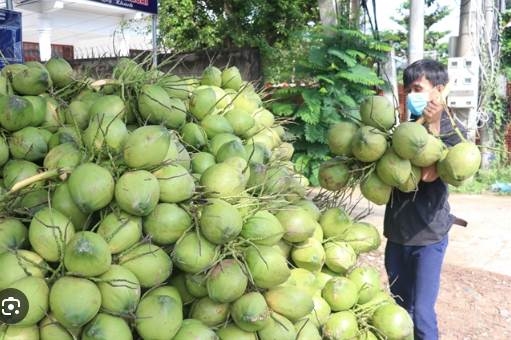Fresh coconut industry growth slows down, warning of market risks
Friday, November 21,2025
AsemconnectVietnam - Fresh coconut prices plummet, exports stagnate, warning coconut industry needs to control quality and plan sustainable production.
Fresh coconut prices plummet, exports face difficulties
Fresh coconut prices are currently falling sharply, while major export markets such as the US and China still maintain high prices. Currently, price of large fresh coconuts is only about 30,000 VND/12 fruits, down more than 50% compared to the same period last year.
The main reason is prolonged rainy weather, low domestic demand, especially in the Central and Northern regions, which are heavily affected by natural disasters. Export market also recorded a slowdown, showing that after a period of strong growth, Vietnamese fresh coconut industry is facing obvious instability.
Speaking to reporters from Industry and Trade Newspaper, Mr. Cao Ba Dang Khoa, Vice President and General Secretary of Vietnam Coconut Association, said that sharp price drop is not only due to seasonal factors but also a sign of hot development, leading to many businesses purchasing and exporting without quality control. “There are containers of coconuts exported to China that are mixed with many varieties, sizes and flavors. As a result, customers return them, and businesses have to sell them cheaply domestically,” Mr. Khoa warned.
Meanwhile, international market requires very strict standards because fresh coconut is a perishable product, completely different from processed products. Therefore, source of raw materials needs to have international certification for sustainable production, ensuring consistent quality. However, in reality, coconut growing areas in Vietnam are still spontaneous, with excess mass production but a lack of products that meet export standards, creating adversity for both businesses and farmers.
Currently, Vietnam grows 16 varieties of drinking coconuts, with many gardens growing them in between. Farmers often want traders to buy all their output, making it difficult to classify and select products for export. “To develop sustainably, coconut industry needs to develop a production plan, improve quality, make information transparent and require farmers to keep a farming diary, which very few people do at present”, Mr. Khoa emphasized.
Mr. Khoa also warned that coconut industry is in a “strong purification” phase. Exporters who cannot manage quality will have to withdraw and go bankrupt, while businesses with good control will have a big advantage. This is a decisive time for all parties to invest in quality, technology and build long-term reputation in the international market.
Coconut export industry still has potential but needs planning
In an interview with Industry and Trade Newspaper, Mr. Nguyen Dinh Tung, Chairman of Board of Directors of Vina T&T Group, Vice Chairman of Vietnam Fruit and Vegetable Association, said that coconut industry still has a lot of potential, especially green and red Siamese coconut varieties that are favored by the international market thanks to their refreshing taste.
As of August 2025, export of fresh whole coconuts reached 115.5 million USD, an increase of 15% over the same period last year; processed coconuts reached 233.7 million USD, an increase of 54%. Total export value in the first 8 months of the year reached 345.2 million USD, showing abundant potential if organized and quality improved.
“With appropriate policies and processes, Vietnamese coconut industry still has a lot of room to become a strategic export product, maximizing the advantages of domestic coconut varieties and increasing international demand,” said Mr. Nguyen Dinh Tung.
Reality from other products shows a clear warning lesson. Dragon fruit used to be a key export crop, bringing in more than 1 billion USD/year, but now only about 500 million USD/year due to a gradual loss of competitiveness. Durian, after a period of record growth in early 2024, faced a big shock when China tightened control of cadmium and yellowing residues, causing export volume to drop by 80% at times. Mr. Dang Phuc Nguyen, General Secretary of the Vietnam Fruit and Vegetable Association, commented: “Durian is a difficult crop to grow, China has tested it on Hainan Island but has not been successful, that is an advantage for Vietnam. However, if quality is not improved and processes are not innovated, this competitive advantage will soon be lost”. This message also applies to the coconut industry, proactively controlling quality, improving competitiveness and innovation are vital factors to maintain market position".
Experts also said that Vietnamese coconut industry is facing strict requirements on international standards, especially when product is aimed at the high-end segment. Successful exports not only depend on quantity but also on consistent quality, food safety and traceability. If not improved, the product will have difficulty competing with Thai coconut or other countries that are applying strict control processes.
Source: Vitic/ congthuong.vn
Fresh coconut prices are currently falling sharply, while major export markets such as the US and China still maintain high prices. Currently, price of large fresh coconuts is only about 30,000 VND/12 fruits, down more than 50% compared to the same period last year.
The main reason is prolonged rainy weather, low domestic demand, especially in the Central and Northern regions, which are heavily affected by natural disasters. Export market also recorded a slowdown, showing that after a period of strong growth, Vietnamese fresh coconut industry is facing obvious instability.
Speaking to reporters from Industry and Trade Newspaper, Mr. Cao Ba Dang Khoa, Vice President and General Secretary of Vietnam Coconut Association, said that sharp price drop is not only due to seasonal factors but also a sign of hot development, leading to many businesses purchasing and exporting without quality control. “There are containers of coconuts exported to China that are mixed with many varieties, sizes and flavors. As a result, customers return them, and businesses have to sell them cheaply domestically,” Mr. Khoa warned.
Meanwhile, international market requires very strict standards because fresh coconut is a perishable product, completely different from processed products. Therefore, source of raw materials needs to have international certification for sustainable production, ensuring consistent quality. However, in reality, coconut growing areas in Vietnam are still spontaneous, with excess mass production but a lack of products that meet export standards, creating adversity for both businesses and farmers.
Currently, Vietnam grows 16 varieties of drinking coconuts, with many gardens growing them in between. Farmers often want traders to buy all their output, making it difficult to classify and select products for export. “To develop sustainably, coconut industry needs to develop a production plan, improve quality, make information transparent and require farmers to keep a farming diary, which very few people do at present”, Mr. Khoa emphasized.
Mr. Khoa also warned that coconut industry is in a “strong purification” phase. Exporters who cannot manage quality will have to withdraw and go bankrupt, while businesses with good control will have a big advantage. This is a decisive time for all parties to invest in quality, technology and build long-term reputation in the international market.
Coconut export industry still has potential but needs planning
In an interview with Industry and Trade Newspaper, Mr. Nguyen Dinh Tung, Chairman of Board of Directors of Vina T&T Group, Vice Chairman of Vietnam Fruit and Vegetable Association, said that coconut industry still has a lot of potential, especially green and red Siamese coconut varieties that are favored by the international market thanks to their refreshing taste.
As of August 2025, export of fresh whole coconuts reached 115.5 million USD, an increase of 15% over the same period last year; processed coconuts reached 233.7 million USD, an increase of 54%. Total export value in the first 8 months of the year reached 345.2 million USD, showing abundant potential if organized and quality improved.
“With appropriate policies and processes, Vietnamese coconut industry still has a lot of room to become a strategic export product, maximizing the advantages of domestic coconut varieties and increasing international demand,” said Mr. Nguyen Dinh Tung.
Reality from other products shows a clear warning lesson. Dragon fruit used to be a key export crop, bringing in more than 1 billion USD/year, but now only about 500 million USD/year due to a gradual loss of competitiveness. Durian, after a period of record growth in early 2024, faced a big shock when China tightened control of cadmium and yellowing residues, causing export volume to drop by 80% at times. Mr. Dang Phuc Nguyen, General Secretary of the Vietnam Fruit and Vegetable Association, commented: “Durian is a difficult crop to grow, China has tested it on Hainan Island but has not been successful, that is an advantage for Vietnam. However, if quality is not improved and processes are not innovated, this competitive advantage will soon be lost”. This message also applies to the coconut industry, proactively controlling quality, improving competitiveness and innovation are vital factors to maintain market position".
Experts also said that Vietnamese coconut industry is facing strict requirements on international standards, especially when product is aimed at the high-end segment. Successful exports not only depend on quantity but also on consistent quality, food safety and traceability. If not improved, the product will have difficulty competing with Thai coconut or other countries that are applying strict control processes.
Source: Vitic/ congthuong.vn
Vietnam's seafood exports reached 9.5 billion USD in 10 months of 2025
Exports to India grew in 10 months of 2025
Machinery and equipment imports reached over 49.55 billion USD in 10 months
Import and export of goods reached over 762 billion USD
Vietnam - China: Trade turnover in 10 months exceeds 208 billion USD
Vietnamese agricultural products set new records
Pangasius exports at end of this year: Great opportunities from CPTPP and Middle East
Golden opportunity for Vietnamese agricultural products in US market
Imports of goods from Germany in first 10 months of 2025
Exports to France in 10 months of 2025 grew
Fruit and vegetable import markets in 10 months of 2025
Exports to China reached over 56.9 billion USD in 10 months of 2025
LPG imports worth over 1.7 billion USD in 10 months of 2025
Warning from EU of 50% reduction, Vietnamese agricultural products record quality improvement

Plan of Hai Duong province for a period of 2021 - 2030, ...
Organize space reasonably and harmoniously, focusing on connecting Hai Duong in common development space, actively contributing to the ...Plan of Hau Giang province in a period of 2021 - 2030, ...
Sustainable forestry development program in a period of ...

LION Championship 25 to feature title showdowns in Khanh ...
LION Championship 25 will take place at Cam Ranh Square in south-central Khanh Hoa province, at 20:00 on August 16, featuring two of the ...Bai Dinh Pagoda named outstanding destination with ...
Party chief attends special political–art programme “Under ...



